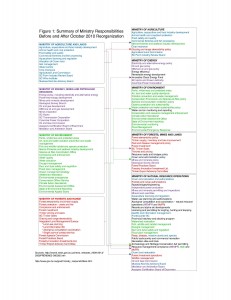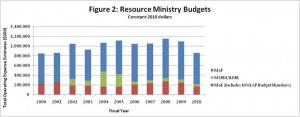George Hoberg and Stephanie Taylor
October 27, 2010
On October 25, 2010, BC Premier Gordon Campbell announced a fundamental restructuring of the organization of the BC government with respect to natural resource management. The government created a new ministry, Natural Resource Operations, and moved many of the responsibilities of existing resource agencies – Energy, Agriculture, Forests, and Environment – to the new ministry. In announcing the changes, the government issued a press release listing the names of new organizations, their ministers and deputy ministers, and the new responsibilities of the ministries. But there was no public explanation or rationale provided for the change, so it is hard to evaluate the government’s thinking. The one quote in the press of a rationale from the Premier is that the change would “allow us to move forward in a comprehensive and integrated manner across the natural resource ministries.” In an internal email circulated among staff in several natural resource ministries, Doug Konkin, deputy minister and chief executive officer of the new Ministry of Natural Resource Operations, described the changes as “formaliz[ing] the “One Land Manager” concept” and better positioning BC to “attract global investment and turn proposed projects and investments into actual worksites and jobs.”
The changes have provoked criticism, including a public outburst by Bill Bennett, Campbell’s own Minister of Energy, that landed on the front page of the Vancouver Sun. Overlooking the well-established convention of cabinet solidarity, Bennett chastised the Premier for making fundamental changes to the organization of natural resources without consulting his caucus or cabinet. The decision was also criticized by a leading environmental group. West Coast Environmental Law expressed concerns about the reorganization creating undue emphasis on expeditious resource approvals at the expense of environmental protections:
The lawyers at West Coast Environmental Law are concerned that BC’s new Ministry of Natural Resource Operations will give industrial users ready access to the province’s natural resources without ensuring environmental protection. The environmental organization argued that the new Ministry was being created to help industry get quick government approvals and that this could well compromise environmental protection.
The Changes in Responsibilities
To display the shift in functions to the new Ministry of Natural Resource Operations (MNRO), we’ve constructed a flow chart that shows the allocation of responsibilities before and after Monday’s announcement, shown in Figure 1 (click on Figure to enlarge). The main thrust of the change is to move operational responsibilities from sector-specific resource ministries to the new MNRO, but leaving the higher level policy development within the sector specific ministries. For example, forest authorizations, such as Forest Stewardship Plan and cutting permit approvals, has been moved to MNRO, but forest stewardship policy remains within the Ministry of Forests (now Forests, Mines and Lands but more on that shortly). Likewise, the Oil and Gas Commission, which approves oil and gas developments, has been moved to the new MNRO, but oil and gas policy remains in the Ministry of Energy.
[Update: For a copy of the OIC, go here. For a copy of Q&A from the government, go here.)
These changes are profound. They are likely to be particularly troubling to entities that have a strong organizational culture. The BC Forest Service, created in 1912, has been moved around and renamed a number of times in its history. But this is the first time we are aware of that core components of it have been divided between different ministries.
In addition to that separation of policy from operations, some policy responsibilities were shifted around. Mining was moved out of Energy and into Forests, and Crown land administration policy was moved from Agriculture to Forests. Forests gave range policy back to Agriculture. Oddly, part of the Integrated Land Management Bureau was moved to the new Ministry of Regional Economic and Skills Development.
The rationale for these changes is presumably to improve the coordination of natural resource operations to expedite approvals and facilitate resource-based economic development. This raises three questions:
- Is it likely to work to rationalize the approval process?
- Are there risks to other values as a result of the changes?
- Is organization design the problem, or is it capacity?
Lessons from Past experience with integration
This is not the first time that the BC government – in fact the Gordon Campbell BC Liberals – has attempted to reorganize government natural resource functions to promote greater integration and efficiency in approvals. When the Campbell government came to power in 2001, it created what they hoped would be a new “super-ministry” in the Ministry of Sustainable Natural Resource Management to improve the integration of natural resource policy and operations. While the original hope was that the new Ministry would facilitate natural resource administration, the end result was that it frustrated it. The problem was that the consolidation of functions was too limited: the Ministries of Forests and Environment still retained significant authority. So instead of reducing transactions costs, the net result was the there was more “red tape” for resource industries. The government dismantled the Ministry of Sustainable Resource Management in 2005, and redistributed its remnants back to the pre-existing resource agencies.
The most organizationally unstable function is arguably one of the most important: land use planning. When the NDP government launched comprehensive land use planning in the 1990s, they coordinated interagency activities through a cabinet office known as the Land Use Coordination Office. The Liberals came to power and created the Ministry of Sustainable Resource Management and housed land use planning functions there. When that ministry was disbanded, the government created the Integrated Land Management Bureau (ILMB) and housed it within the Ministry of Agriculture and Lands. In 2009, ILMB was moved over to the Ministry of Forests and Range. In this latest reorganization, ILMB as such has disappeared. The fate of some of its responsibilities is unclear, but the once-pivotal responsibility for land-use planning has been relegated the new Ministry of Regional Economic and Skills Development. It is hard to see how that move will improve coordination of natural resource management in the province.
The risks of separating policy from operations
Reorganizations are typically designed to address a particularly salient problem, but frequently create unintended consequences. Concentrating all natural resource operations in one ministry may facilitate project review and approvals, but separating operations from policy might create other problems. One risk is that organizational learning might become even more challenging. Policy reform should be informed by operational experience, but if the feedback from that operational experience needs to cross more organizational boundaries, it is less likely to be communicated effectively.
Another risk is that policy signals might not be received as well, and it might be more difficult for policy makers to monitor implementation. This risk is the basis for environmental group concern that environmental values might receive less attention in the reorganization.
Is organizational design the problem, or is it capacity?
This major reorganization is based on a premise that the previous structure was deeply flawed. Another view is that the fundamental problem is one of capacity – the financial and human resources to perform the governance functions effectively. Insufficient capacity is a core part of the critique of the decision leveled in Energy Minister Bennett’s criticism of Campbell’s decision:
The fundamental problem facing the natural resource ministries is they’re underfunded. We work the heck out of them [the employees] and we don’t have enough funds within these ministries to get the permits out the door, to develop the policy, to deal with the stakeholders, to do the work that actually leads to the majority of the revenue that comes in to government.
An analysis of changes in resource ministry budgets and personnel does show a significant decline over the past several years. Figure 2 show budget trends over the past decade for three major resource functions (Environment, Forests, and land use) (constant 2010 dollars). Budgets did increase in the late 2000s and peaked in 2008 but have declined precipitously since then. The three resource agencies combined saw their budgets drop by 27% between 2008 and 2010.
These recent reduction in budgetary and staff resource suggest that capacity is a major challenge for the resource agencies. Perhaps the reorganization will help the government cope with this challenge, but Minister Bennett, for one, is skeptical.
Conclusion
These organizational changes are dramatic; they appear to be significantly bigger than the reorganizations that occurred early in the Campbell government’s first term. That earlier experiment was acknowledged to be a failure. Whether this new effort to improve the organization of natural resource management in the province will be more successful remains to be seen. It would certainly be useful for the government to provide its officials as well as members of the public with a clearer rationale for the changes that shows how the lessons from past efforts at redesign and the risks to coordination and learning have been considered and addressed




Pingback: Tweets that mention One Land Manager, or Seven? The 2010 Reorganization of Natural Resource Management in BC | GreenPolicyProf -- Topsy.com
This is an excellent service and analysis, George and Stephanie. Thank you for undertaking this considerable effort to inform us all, and so quickly after the shuffle.
Thank you George and Stephanie for this fast analysis. Even within the former B.C. Forest Service, it was always challenging to maintain dialogue and linkages between forest policy and operations at provincial, regional and local scales. That was between two divisions, not two ministries as we now have.
Check this spring Budget document for the budget estimates in 2012-2014 and add these to your graphs to see the trend.
The big changes between MSRM and MNRO is the legislation (power) and entire field operations have moved to the new ministry. The capacity and size of MNRO dwarfs the MSRM mistake.
To be fair about diminishing budgets, you have to look at the revenues being generated by the sectors. It doesn’t make sense to continue to spend the same or more money on diminishing returns…what has to happen next is simpler, faster policy to support NR business and mounting First Nation’s issues. Otherwise the entire system will lock up in it’s own bureacratic confusion…and I’d say it’s petty close to chaos now.
I would be surprised this new organization will lead to positive results. My experience when policy is separated from operations the result is major delays in moving forward. Operations and policy people think about issues differently and have different objectives. When there is no clear authority (i.e., one boss) a lot of discussion and time occurs. This type of organization is dependent upon the ability of the policy people to \convince\ operations that changes are good. Couple the differences in performance measures and the lack of skills in convincing people in the policy arena, operations will be king. I would like to see the rationale for the change.
I agree with others who have commented about it not being appropriate to make comparisons between MSRM and the new MNRO; you really are trying to compare apples to oranges or perhaps even fruit to vegetables.
I would also note that “land use planning” has not been a significant program for several years now. It has been essentially been replaced by negotiated land and resource use agreements between the Crown and First Nations. I also note that many of these plans are very dated (having been developed 10 or more years ago for much of the interior of the province) and given the prescriptive nature of many of these plans I would be interested to learn how much they actually influence operational level management and decision making today.
One challenge with linking sector revenues to the amount that is spent on “administering” that sector is that this approach does not take into account the amount of work involved in actually processing authorizations for the activities of that sector. In some instances perhaps the Crown could price tenures to more accurately reflect the amount of effort involved in processing the application in question.
I would also argue that in some instances the Crown undervalues the revenue that could have been generated from its land and resource assets. For example, what if rather than allowing a “gold rush” for “staking” of potential run of river IPP sites the Crown had instead only made a small number of sites available at a time and used some sort of competitive bid process to see who got the rights to a site? I would speculate that the Crown may have gotten a better return in the long run. I would point to the agreements that First Nations are able to negotiate with IPP developers as evidence of what the Crown may have been able to achieve. But this is a whole other topic for discussion.
I just spend one semester’s administration class learning in depth, the procedures and policies of the MOFR… now i have to re-learn a new system. Thanks Gordon Campbell for making my post secondary experience yet again more challenging. However, thank you George and Stephanie for taking the time to quickly formulate an analysis of this remodeling. The article was informing and promoted discussion.
Pingback: One Land Manager, or Seven? The 2010 Reorganization of Natural Resource Management in BC - FACT – Forests and Communities in Transition
There is no question that this reorganization is badly needed. Sclerosis has settled in the diverse ministries where each deals with the elephant in the room from a very small self-centered vantage – reminds me of the 7 blinds who were trying to feel a small part of the elephant and describe the creature.
Not only some ministries are rafe with rogue agents who decide for themselves what values should be imposed on the rest of society, but to make matters worse, none of this set of diverse agents have any background or inclination to consider tax income and revenue generation in evaluating an application on hand. Therefore it is quite common that some recent college graduate in cultural theory in order to save \minnows\ ends up rejecting a sustainable project that could bring millions in revenue to multiple levels of government and First Nations.
The ideological impoverishment of the province continues with the bureaucracy in total control and also in many ways subservient to the extremely highly paid public unions. This charade has to end. If there is a better way to do that – I am all ears. However, the current system of layers and layers of bureacracy with very little accountibility and rampant ideological activism and diverse specialty fiefdoms within government must change.
One more bitter pill to swallow. The Government has still not got it … that policy decisions that are not sensitive to the need to adapt practices to local social and environmental circumstances, that a focus on preparation of management plans by way of delegation to the industry (no change here) whose main goal is to acquire property rights and permits for specific activities, not land management, and that a streamlined system of government permits and approvals aimed at reducing transaction costs and increasing government revenues, does not, and will not make for efficient and effective land management. This is defacto land management at best.
The ability to tailor research, policy, planning and practice must be delegated to a central authority on a more local scale so as to grant more flexibility in the responses to issues like climate change and to place responsibility for the social, economic and environmental outcomes in the hands of those that are most knowledgeable about their situation and will be most impacted by the decisions. As is indicated in the article above – instead of structuring research, policy, planning and practice to underwrite such flexible responses, the Government has decided in its own wisdom to stretch the very bonds of these 4 corner stones of effective land management coordination even more than was the case under the old regime. Frustrations with lack of control will increase on the local scale, and the Government will have to respond by way of triage of the treatment of those frustrations through a highly centralized form of government due to the lack of empowered decision makers lower in the hierarchy. Important issues will be missed and unintended consequences will continue to perpetuate themselves throughout this centralized system, as in the past, for example through “sudden” outbreaks of large scale social unrest about the way forests are being managed, catastrophic fires, and bark beetles, all of which could be, and in fact were, anticipated and yet not responded to because the voices were too few and not loud enough until after the events occurred.
Pingback: Premier Christy Clark: More Reorganization of BC Natural Resource Ministries | GreenPolicyProf